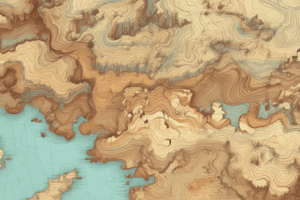Podcast
Questions and Answers
What does the merging of two or more contour lines signify on a topographical sheet?
What does the merging of two or more contour lines signify on a topographical sheet?
Vertical slopes such as cliffs or waterfalls.
Why do contour lines of different elevations usually not cross each other?
Why do contour lines of different elevations usually not cross each other?
Because each contour line represents a specific elevation.
What are the horizontal lines on a topographical grid called?
What are the horizontal lines on a topographical grid called?
Northings.
In grid references, which is mentioned first: eastings or northings?
In grid references, which is mentioned first: eastings or northings?
What is the difference between 4 figure and 6 figure grid references?
What is the difference between 4 figure and 6 figure grid references?
On a topographical map scale of 1:50,000, how large is each grid square?
On a topographical map scale of 1:50,000, how large is each grid square?
What is a saddle in the context of topographical features?
What is a saddle in the context of topographical features?
How are contours spaced on a concave slope?
How are contours spaced on a concave slope?
Describe the contour spacing on a convex slope.
Describe the contour spacing on a convex slope.
What is the primary distinguishing feature of a mountain?
What is the primary distinguishing feature of a mountain?
Flashcards are hidden until you start studying
Study Notes
Basic Rules of Topographical Sheets
- When contour lines merge, they represent vertical slopes such as cliffs or waterfalls.
- Contour lines of different elevations do not cross each other.
- A grid on a topo map consists of northings (horizontal lines) and eastings (vertical lines) used to locate features.
- Grid references are written with eastings first, followed by northings.
- There are two types of grid references: 4 Figure (for a specific grid square) and 6 Figure (for more accurate location).
Drawing a Cross-Section of a Relief Feature
- A cross-section provides a 3D impression of a relief feature based on contours.
- On a 1:50,000 scale map, each grid square measures 2 cm x 2 cm or 1 km x 1 km.
- The area of each square is 1 sq.km.
- To draw a cross-section, start with a base line, choose a suitable vertical scale, and draw the section.
Pass, Saddle, Col and Mountain
- Mountains are characterized by their height, not multiple anticlines.
- A pass is a break in a mountain range with a lower height than surrounding mountains.
- A saddle is a low ground in the highlands, resembling a horseback, and acts as a passage.
Concave and Convex Slopes
- A concave slope has a gentle gradient in lower parts and is steep in upper parts.
- Contours on a concave slope are widely spaced in lower parts and closely spaced in upper parts.
- A convex slope is gentle in upper parts and steep in lower parts.
- Contours on a convex slope are widely spaced in upper parts and closely spaced in lower parts.
Studying That Suits You
Use AI to generate personalized quizzes and flashcards to suit your learning preferences.




